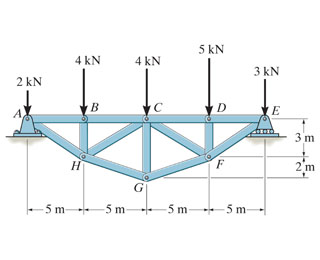Determine the force:
Determine the force P needed to start block B illustrated in Figure moving to the right if the coefficient of friction is 0.3 for all surfaces of contact. Block A weighs 80 N and block B weighs 160 N.

Solution
Figure illustrates the free body diagrams for block A and block B. As the possible motion of the block B is towards right, the direction of frictional forces FA & FB are illustrated acting towards left, for block B. While block B moves towards right the relative motion of block A shall be towards left and therefore the frictional force FA for block A is illustrated acting towards right.
Now the conditions of equilibrium may be applied to determine the force P.
For Block A
∑ Fx = 0
∴ FA = T cos 30o = 0.866 T ------------ (1)
(where, T is the tension in the given cord)
∑ Fy = 0
∴ N A = WA - T sin 30o
= 80 - 0.5 T -------------- (2)
Also FA = μ N A
∴ 0.866 T = 0.3 (80 - 0.5 T)
∴ T = 24/1.016 = 23.62 N -------- (3)
For Block B
∴ FA = 0.866 × 23.62 = 20.45 N
∴ N A = 80 - 0.5 × 23.62 N
= 68.19 N
∑ Fy = 0
∴ N B = N A + WB
= 68.19 + 160
= 228.19 N ---------- (4)
FB = μ N B
= 0.3 × 228.19
= 68.46 N
∑ Fx = 0 ----------------( 5)
∴ P = FA + FB
= 20.45 + 68.46
= 88.91 N ----------- (6)
Thus, a force 88.91 N is needed to move the block B to the right.